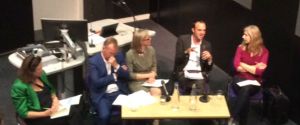This post was contributed by Lucia Magis-Weinberg, who is doing her PhD under the supervision of Dr Dumontheil and Dr Custers, investigating how motivation impacts adolescents’ executive functions (which include self-regulation and attention). Learn more about Dr Dumontheils’ research. Follow us on Twitter @idumontheil and @luciamawe.
 Inhale. Exhale. Focus your attention on the present moment. Mindfulness meditation (MM) is a type of awareness that involves focusing on moment to moment experiences in a non-judgmental and non-reactive way. MM was adopted from the Buddhist tradition, and was originally implemented in Western medicine for the treatment of chronic intractable pain. In adults, it has been shown to improve people’s ability to manage attention, regulate emotion, well-being, and ameliorate anxiety and depression. It even boosts immune function. But can these benefits be extended to other age groups?
Inhale. Exhale. Focus your attention on the present moment. Mindfulness meditation (MM) is a type of awareness that involves focusing on moment to moment experiences in a non-judgmental and non-reactive way. MM was adopted from the Buddhist tradition, and was originally implemented in Western medicine for the treatment of chronic intractable pain. In adults, it has been shown to improve people’s ability to manage attention, regulate emotion, well-being, and ameliorate anxiety and depression. It even boosts immune function. But can these benefits be extended to other age groups?
This was discussed as part of the Birkbeck Science Week by Dr Iroise Dumontheil from the Department of Psychological Sciences, who talked about her ongoing research on the effects of mindfulness meditation training (MMT) in adolescence. The teenage years are characterised by continued improvements in self-regulation, the ability to exert voluntary control on thought, emotion and action. A deficit in self-regulation results in impaired impulse control and increased sensation seeking and risk taking. Furthermore, adolescents can struggle with the regulation of emotions. Failures in self-regulation can have a bigger impact in decisions and behaviour in the teenage years than later in life, as is evident by the alarmingly high rates of death by accidents and violence, two preventable issues, in the second decade of life. Around 75% of mental disorders have an onset before the age of 24. All of these issues could benefit from enhancing the ability of adolescents to self-regulate. Can MMT be one of the ways? Dr Dumontheil’s ongoing research, conducted in collaboration with UCL and the University of Minnesota, is starting to address this question and is motivated by the impact that interventions could have on adolescent well-being.
There is some initial promise from early research in the adolescent population. It has been shown that MMT is feasible in adolescence, particularly because it could be done in schools. MMT seems to benefit performance in tasks that involve a negative emotional component (being less distracted by angry faces, for example). Additionally, there is evidence that anxiety is decreased. The positive effects of MMT on increased attentional control are similar to those seen previously in adult studies.
Currently, Dr Dumontheil is looking at changes in brain function in response to an 8-week MMT with fMRI, a neuroimaging technique. In adults, it has been shown previously that MMT reinforces self- regulation by targeting the ability to control thought and action (associated with increased activity in the prefrontal regions of the brain) and lessening the influence of anxiety, stress and immediate reactivity (associated with decreased activity in the amygdala). Preliminary data from Dr Dumontheil’s research show changes in the brain regions that control attention.
As was noted by attendees of the lecture, there are very interesting questions yet to be explored, such as gender differences in the response to MMT and whether variants of the standard MMT may be more successful in adolescents and children. While research in psychology and neuroscience shed light on this interesting phenomenon, let’s reorient our attention to our present moment for now. Inhale. Exhale.


